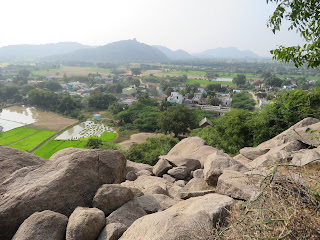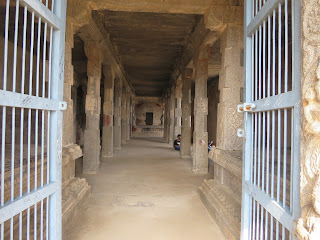About the trip
The plan was to visit 4 - 5 ancient temples of Lord Shiva in half a day. The temples that were planned to visit were across the belt of Sriperumpudur to Thirumalpur. These temples are a part of 276 Padal Petra Sthalams of Lord Shiva.
Trip Plan
Trip : Chennai - Sriperumpudur (via) - Koovam - Thakkolam - Thirumalpur - Chennai
Trip Dates: 23 February 2020
Trip Mates: Karthik and family, Siva and family
Day started by 5:30 AM from home and the plan was to visit 4 of the Shiva's Padal Petra Sthalams Enroute Thirumalpur. We also planned to visit Sriperumpudur Adhi Kesava Perumal temple, however, skipped because of few dependencies.
TNT014 - Sri Thiripuranthakar Temple (Koovam Shivan Temple - Tiruvirkolam)
Deity: Thirupuranthakar (Lord Shiva), Goddess Thirupuranthaka Nayaki
About: This is one of the 276 Paadal Petra Sthalams. This is 14th Shiva Sthalam in Thondai Nadu.
Timing : 6:00 AM to 11:30 AM, 5 PM to 7 PM.
Parking: Available for a few vehicles
Route: This temple is around 20 km (45 mins drive) from Sriperumpudur. The roads are quite good. Can be located easily in Google maps.
History: This temple is a remote temple in the village of Koovam. Please do locate the water tank on the main road and the roads by its sides would take you to the temple main entrance. There is an injury scar on the Lingham and all abishekams are done without touching the Lingam. The Lingham is Theenda Thirumeni. The Lingam is said to change colour based on weather - rain and flood situations. The temple is absolutely serene and divine.
TNT013 - Sri Deivanaatheswarar Temple (Ilambayankottur Shivan Temple)
Deity: Sri Arambeswarar (Lord Shiva), Goddess Kanaka Kujambikai
About: This is one of the 276 Paadal Petra Sthalams. This is 13th Shiva Sthalam in Thondai Nadu.
Timing : 7:00 AM to 12:00 PM, 4 PM to 7 PM.
Parking: Available for 2-3 cars
Route: This temple is around 9 km (20 mins drive) from Koovam Shivan temple. Interior Roads are village roads and quite bad. Can be located in Google maps - avoid any mud road the maps might show. Look for alternate paved roads and proceed.
History: This temple is looked upon as a temple where Lord Shiva was worshipped by other Gods. The Swayambu lingam is said to be in red colour for a few months and in white colour for a few months.
TNT012 - Sri Jalanatheeswarar / Gangadhareswarar Temple (Thakkolam Shivan Temple - Tiruvooral)
Deity: Sri Jalanatheeswarar (Lord Shiva), Goddess Giriraja Kannikambhal
About: This is one of the 276 Paadal Petra Sthalams. This is 12th Shiva Sthalam in Thondai Nadu.
Timing : 7:00 AM to 12:00 PM, 4:30 PM to 7:30 PM.
Parking: Available for a few cars
Route: This temple is around 11 km (25 mins drive) from Ilambayankottur - Shivan temple. The temple is on a road inside the town of Thakkolam. Can be easily located in Google maps.
History: The Lingham is Theenda Thirumeni. It is believed this lingam was created by Goddess Parvathi and hugged by her. Lord Vishnu sits behind Lord Shiva sanctum instead of Lingothbahvar. The temple is also a Guru Parihara sthalam. Lord Dhakshinamoorthy sits in a different posture in this temple - legs crossed and Goddess Durga in dancing form.
We decided to have some breakfast in Thakkolam. We stopped by a small mess, probably, the most popular and biggest in Thakkolam! Pongal, vadai, idlies, and poori - all were good. The place was Prakash Bhavan.
TNT011 - Sri Manikandeswarar Temple (Tirumalpur Shivan Temple - Tirumarperu)
Deity: Sri Manikandeswarar (Lord Shiva), Goddess Anchanatchi Amman
About: This is one of the 276 Paadal Petra Sthalams. This is 11th Shiva Sthalam in Thondai Nadu.
Timing : 7:00 AM to 12:00 PM, 5:00 PM to 8:30 PM.
Parking: Lots of space for cars
Route: This temple is around 20 km (30 mins drive) from Thakkolam and 8 km before entering Vellore Highway. From Arakonam road, one has to be through the underpass of the railway line coming closer to the Tirumalpur railway station. Can be easily located in Google maps.
History: The Lingham is said to be worshipped for Lord Vishnu. When Lord Vishnu offered 1000 flowers to Lord Vishnu, there was one short and Lord Vishnu offered his eye. Lord Vishu was then called Senthamarai Kannan and also he got Sudharashana Chakra here.
Sri Dakshinamoorthy temple (Govindavadi)
Deity: Sri Dakshinamoorthy (Lord Shiva)
About: Exclusive temple for Lord Guru Dakshinamoorthy.
Timing : 8:00 AM to 12:00 PM, 4:00 PM to 8:00 PM.
Parking: Parking area available.
Route: This temple is around 8 km (20 mins drive) from the Tirumalpur Shiva temple. One needs to cross the railway gate and reach the temple. Can be located in Google maps with ease.
History: The temple hosts Guru Dakshinamoorthy as the main deity and Lord Kailashanathar sanctum separately. The deity sits over a pedestal and absolutely stunning. Great divinely feel.
Trip Dates: 23 February 2020
Trip Mates: Karthik and family, Siva and family
Day started by 5:30 AM from home and the plan was to visit 4 of the Shiva's Padal Petra Sthalams Enroute Thirumalpur. We also planned to visit Sriperumpudur Adhi Kesava Perumal temple, however, skipped because of few dependencies.
TNT014 - Sri Thiripuranthakar Temple (Koovam Shivan Temple - Tiruvirkolam)
Deity: Thirupuranthakar (Lord Shiva), Goddess Thirupuranthaka Nayaki
About: This is one of the 276 Paadal Petra Sthalams. This is 14th Shiva Sthalam in Thondai Nadu.
Timing : 6:00 AM to 11:30 AM, 5 PM to 7 PM.
Parking: Available for a few vehicles
Route: This temple is around 20 km (45 mins drive) from Sriperumpudur. The roads are quite good. Can be located easily in Google maps.
History: This temple is a remote temple in the village of Koovam. Please do locate the water tank on the main road and the roads by its sides would take you to the temple main entrance. There is an injury scar on the Lingham and all abishekams are done without touching the Lingam. The Lingham is Theenda Thirumeni. The Lingam is said to change colour based on weather - rain and flood situations. The temple is absolutely serene and divine.
TNT013 - Sri Deivanaatheswarar Temple (Ilambayankottur Shivan Temple)
Deity: Sri Arambeswarar (Lord Shiva), Goddess Kanaka Kujambikai
About: This is one of the 276 Paadal Petra Sthalams. This is 13th Shiva Sthalam in Thondai Nadu.
Timing : 7:00 AM to 12:00 PM, 4 PM to 7 PM.
Parking: Available for 2-3 cars
Route: This temple is around 9 km (20 mins drive) from Koovam Shivan temple. Interior Roads are village roads and quite bad. Can be located in Google maps - avoid any mud road the maps might show. Look for alternate paved roads and proceed.
History: This temple is looked upon as a temple where Lord Shiva was worshipped by other Gods. The Swayambu lingam is said to be in red colour for a few months and in white colour for a few months.
Deity: Sri Jalanatheeswarar (Lord Shiva), Goddess Giriraja Kannikambhal
About: This is one of the 276 Paadal Petra Sthalams. This is 12th Shiva Sthalam in Thondai Nadu.
Timing : 7:00 AM to 12:00 PM, 4:30 PM to 7:30 PM.
Parking: Available for a few cars
Route: This temple is around 11 km (25 mins drive) from Ilambayankottur - Shivan temple. The temple is on a road inside the town of Thakkolam. Can be easily located in Google maps.
History: The Lingham is Theenda Thirumeni. It is believed this lingam was created by Goddess Parvathi and hugged by her. Lord Vishnu sits behind Lord Shiva sanctum instead of Lingothbahvar. The temple is also a Guru Parihara sthalam. Lord Dhakshinamoorthy sits in a different posture in this temple - legs crossed and Goddess Durga in dancing form.
We decided to have some breakfast in Thakkolam. We stopped by a small mess, probably, the most popular and biggest in Thakkolam! Pongal, vadai, idlies, and poori - all were good. The place was Prakash Bhavan.
TNT011 - Sri Manikandeswarar Temple (Tirumalpur Shivan Temple - Tirumarperu)
Deity: Sri Manikandeswarar (Lord Shiva), Goddess Anchanatchi Amman
About: This is one of the 276 Paadal Petra Sthalams. This is 11th Shiva Sthalam in Thondai Nadu.
Timing : 7:00 AM to 12:00 PM, 5:00 PM to 8:30 PM.
Parking: Lots of space for cars
Route: This temple is around 20 km (30 mins drive) from Thakkolam and 8 km before entering Vellore Highway. From Arakonam road, one has to be through the underpass of the railway line coming closer to the Tirumalpur railway station. Can be easily located in Google maps.
History: The Lingham is said to be worshipped for Lord Vishnu. When Lord Vishnu offered 1000 flowers to Lord Vishnu, there was one short and Lord Vishnu offered his eye. Lord Vishu was then called Senthamarai Kannan and also he got Sudharashana Chakra here.
Sri Dakshinamoorthy temple (Govindavadi)
Deity: Sri Dakshinamoorthy (Lord Shiva)
About: Exclusive temple for Lord Guru Dakshinamoorthy.
Timing : 8:00 AM to 12:00 PM, 4:00 PM to 8:00 PM.
Parking: Parking area available.
Route: This temple is around 8 km (20 mins drive) from the Tirumalpur Shiva temple. One needs to cross the railway gate and reach the temple. Can be located in Google maps with ease.
History: The temple hosts Guru Dakshinamoorthy as the main deity and Lord Kailashanathar sanctum separately. The deity sits over a pedestal and absolutely stunning. Great divinely feel.


































































